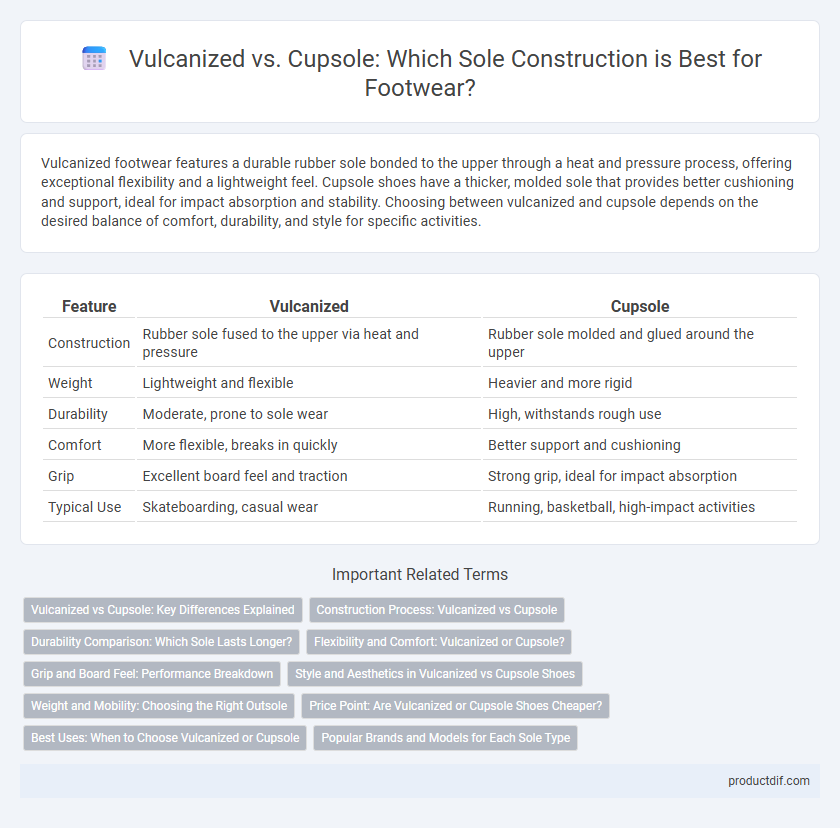Vulcanized footwear features a durable rubber sole bonded to the upper through a heat and pressure process, offering exceptional flexibility and a lightweight feel. Cupsole shoes have a thicker, molded sole that provides better cushioning and support, ideal for impact absorption and stability. Choosing between vulcanized and cupsole depends on the desired balance of comfort, durability, and style for specific activities.
Table of Comparison
| Feature | Vulcanized | Cupsole |
|---|---|---|
| Construction | Rubber sole fused to the upper via heat and pressure | Rubber sole molded and glued around the upper |
| Weight | Lightweight and flexible | Heavier and more rigid |
| Durability | Moderate, prone to sole wear | High, withstands rough use |
| Comfort | More flexible, breaks in quickly | Better support and cushioning |
| Grip | Excellent board feel and traction | Strong grip, ideal for impact absorption |
| Typical Use | Skateboarding, casual wear | Running, basketball, high-impact activities |
Vulcanized vs Cupsole: Key Differences Explained
Vulcanized footwear features a flexible, thin sole bonded to the upper through heat and pressure, offering superior board feel and lightweight durability, ideal for skateboarding and casual wear. Cupsole shoes have thicker, molded soles with enhanced cushioning and support, providing better impact absorption and long-term comfort suited for athletic activities. The key differences lie in construction, flexibility, and purpose, with vulcanized shoes excelling in grip and responsiveness while cupsoles deliver stability and protection.
Construction Process: Vulcanized vs Cupsole
Vulcanized footwear features a construction process where the rubber sole is heat-treated and chemically bonded to the upper, creating a flexible and durable shoe that adapts well to foot movements. Cupsole construction involves injecting or molding a thick rubber or EVA midsole around the footbed, providing enhanced cushioning, support, and structural stability. Understanding the differences in these methods helps consumers choose between the lightweight, pliable characteristics of vulcanized soles and the cushioned, impact-resistant benefits of cupsoles.
Durability Comparison: Which Sole Lasts Longer?
Vulcanized soles, composed of rubber heated and bonded through a chemical process, offer superior flexibility but tend to wear down faster under heavy use. Cupsole construction, featuring thicker, molded rubber outsoles fused to the shoe's midsole, delivers enhanced durability and cushioning, making it ideal for high-impact activities. Overall, cupsoles generally last longer than vulcanized soles due to their robust build and resistance to abrasion.
Flexibility and Comfort: Vulcanized or Cupsole?
Vulcanized footwear offers superior flexibility due to the heat-bonded rubber process, allowing the shoe to bend naturally with the foot for enhanced comfort during extended wear. Cupsole designs provide better cushioning and support with a molded midsole, resulting in greater shock absorption but less flexibility. Choosing between vulcanized and cupsole depends on prioritizing lightweight flexibility versus structured comfort for specific activities.
Grip and Board Feel: Performance Breakdown
Vulcanized soles offer superior board feel due to their thinner rubber construction, allowing for enhanced flexibility and close contact with the skateboard deck. Cupsole shoes provide better grip and impact protection through their thicker, molded rubber outsole, which often includes deeper tread patterns for increased traction. Choosing between vulcanized and cupsole depends on whether the skater prioritizes sensitivity and control or durability and cushioning during performance.
Style and Aesthetics in Vulcanized vs Cupsole Shoes
Vulcanized shoes feature a sleek, flexible design with a thin sole that enhances board feel and offers a classic, minimalist aesthetic favored in skate culture and casual wear. Cupsole shoes provide a bulkier, structured look with thicker soles that emphasize durability and support, often preferred for their rugged, robust style. The streamlined silhouette of vulcanized footwear contrasts with the substantial profile of cupsole models, influencing overall outfit aesthetics and personal style choices.
Weight and Mobility: Choosing the Right Outsole
Vulcanized outsoles are lighter and more flexible, offering enhanced mobility for activities requiring quick movements and agility. Cupsole outsoles provide greater cushioning and support but tend to be heavier, which can slightly reduce speed and fluidity. Selecting the right outsole depends on prioritizing either lightweight performance with vulcanized soles or durability and impact protection with cupsoles.
Price Point: Are Vulcanized or Cupsole Shoes Cheaper?
Vulcanized shoes generally have a lower price point due to their simpler manufacturing process and use of less material compared to cupsole shoes. Cupsole shoes often cost more because of their complex sole construction, enhanced cushioning, and durability features that require advanced materials and technology. Consumers prioritizing affordability typically opt for vulcanized footwear, while those seeking performance and longevity tend to invest in cupsole models.
Best Uses: When to Choose Vulcanized or Cupsole
Vulcanized shoes offer exceptional flexibility and lightweight comfort, making them ideal for casual wear and skateboarding due to their superior board feel and grip. Cupsole shoes provide enhanced support and durability with thicker midsoles, suited for activities requiring impact protection, such as basketball or long walks. Choose vulcanized for agility and cupsole for stability and cushioning in more demanding environments.
Popular Brands and Models for Each Sole Type
Vulcanized soles, favored by brands like Vans and Converse, offer flexibility and a classic look ideal for skateboarding and casual wear, with iconic models such as Vans Old Skool and Converse Chuck Taylor All Star. Cupsole designs, utilized by Nike and Adidas, provide enhanced cushioning and durability, popular in performance sneakers like the Nike Air Force 1 and Adidas Superstar. Each sole type delivers distinct benefits tailored to specific activities, influencing brand innovation and consumer preferences in the footwear market.
Vulcanized vs Cupsole Infographic

 productdif.com
productdif.com